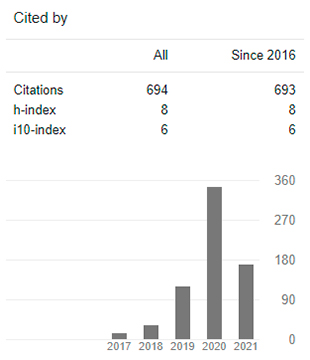Medicinal Plant Gardens as an Option to the Development of an Environmental Culture
DOI:
https://doi.org/10.29394/scientific.issn.2542-2987.2017.2.3.7.138-154Keywords:
environmental culture, values, garden, medicinal plantsAbstract
This research aims to implement a medicinal plant gardens as an option to create values in an environmental culture in the Francisco Tamayo Technical School located in Barinitas parish, Bolívar municipality state Barinas. The approach of this study is qualitative thorough the participatory action research. Besides, it supports the field method and its methodological design is structured in four phases: (1) Reflection, (2) Planning, (3) Execution Plan, scopes and limitations (4) Reflection about all the process. The key people will be: (01) teacher, (03) students, (01) representative and a school worker who will give the accurate information to plan and execute the strategies. The technique of gathering information will be the participatory observation and the deep interview. The analysis techniques of gathering information will be the categorization to reduce, describe and interpretate it. Among the preliminary considerations are expected students get values to encourage the development of a sustainable environmental culture. It will also allow learning opportunities where involve the cognitive experience with the existential throughout field practices.
Downloads
References
Albert, M. (2007). La Investigación Educativa. Claves Teóricas. España: McGraw-Hill.
Alberto, O. (2001). Medio ambiente y educación: Capacitación en educación ambiental para docentes. 2da edición, ISBN: 987-538-026-1. Argentina: Ediciones Novedades Educativas.
Artieda, G. (1999). Educación ambiental: Cuestiones básicas. Lurralde, 22, 279-298, e-ISSN: 1697-3070. España.
Ballesta, C. (2006). Manual de Jardinería. Ediciones Ceac. S.A.
Bermúdez, A. (2004). Caracterización del comercio de plantas medicinales en los mercados populares de Caracas, Venezuela. 2do. Seminario Iberoamericano de Comercialización de Plantas Medicinales y Aromáticas. Bogotá, Colombia. 59-70.
Castillo, E., y Vásquez, M. (2003). El rigor metodológico en la investigación cualitativa. Colombia Médica, 34(3), 164-167, e-ISSN: 0120-8322. Recuperado de: https://www.redalyc.org/articulo.oa?id=28334309
Cisterna, F. (2005). Categorización y Triangulación. C.A-ORIAL ediciones.
ConceptoDefinición (2004). Hierbas medicinales. [Diccionario en línea]. Recuperado de: http://conceptodefinicion.de/hierbas-medicinales/
Guba, G. E. y Lincoln, Y. S. (1982). Effective evaluation. San Francisco: Jossey Bass Publishers.
Kemmis, S. y McTaggart, R. (1988). Cómo Planificar la investigación Acción. Barcelona: ALERTES.
Labrador, C., y Del Valle, Á (1995). La Educación Medioambiental en los documentos internacionales: Notas para un estudio comparado. Revista Complutense de Educación, 6(2). Madrid: Servicio de Publicaciones de la Universidad Complutense.
Martínez, M. (1991). La investigación cualitativa etnográfica en educación: Manual teórico – práctico. Venezuela: Texto.
Olaya, J. (2003). Guía de plantas y productos medicinales. Editorial Luis Enrique Acero Duarte.
Rojas, B. (2010). Investigación Cualitativa. Segunda edición Caracas. FEDUPEL.
Vovides, A., Linares, E., y Bye, R. (2010). Jardines botánicos de México: historia y perspectivas. ISBN: 978-607-7579-18-2. México: Secretaría de Educación de Veracruz.
Downloads
Published
How to Cite
Issue
Section
License
The content of the journals of this site, are under a Creative Commons Attribution-Noncommercial-Share Alike 4.0 International License.













